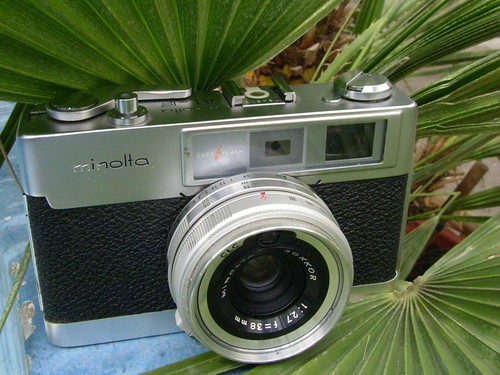Difference between revisions of "Minolta AL-F"
(rights) |
m (cwikilink) |
||
| Line 9: | Line 9: | ||
[[Minolta]] launched this rangefinder camera in 1967. It had an automatic mode for flash photography ("Easy Flash"). Therefore it had a [[guide number]] selector. A [[hot shoe]] for the flash gave further ease of flash usage. For manual exposure selection it offered [[shutter priority]] mode with preselection of five exposure times from 1/30 sec to 1/500 sec. The frame viewfinder was coupled to a superimposed [[rangefinder (device)|rangefinder]] and had a mechanical horizontal [[parallax]] correction. For vertical parallax only a parallax arrow. The [[CdS]] [[Light meter|exposure meter]]'s aperture value proposal for the automatic aperture was visible through the finder, at the right side of the viewfinder image. The lens, a [[Rokkor]] 1:2,7/38mm, had only 4 elements in three groups, and a Seiko shutter. The meter's "eye" was placed within the filter ring of the lens. | [[Minolta]] launched this rangefinder camera in 1967. It had an automatic mode for flash photography ("Easy Flash"). Therefore it had a [[guide number]] selector. A [[hot shoe]] for the flash gave further ease of flash usage. For manual exposure selection it offered [[shutter priority]] mode with preselection of five exposure times from 1/30 sec to 1/500 sec. The frame viewfinder was coupled to a superimposed [[rangefinder (device)|rangefinder]] and had a mechanical horizontal [[parallax]] correction. For vertical parallax only a parallax arrow. The [[CdS]] [[Light meter|exposure meter]]'s aperture value proposal for the automatic aperture was visible through the finder, at the right side of the viewfinder image. The lens, a [[Rokkor]] 1:2,7/38mm, had only 4 elements in three groups, and a Seiko shutter. The meter's "eye" was placed within the filter ring of the lens. | ||
| − | This camera requires a battery to function. It was originally designed to take a PX13 or [[PX625]] [[Mercury Cells|mercury battery]], but nowadays a 1.35v MRB625 Wein Cell would be required. | + | This camera requires a battery to function. It was originally designed to take a PX13 or [[PX625]] [[Mercury Cells|mercury battery]], but nowadays a 1.35v MRB625 [[Wein]] Cell would be required. |
== Links == | == Links == | ||
Revision as of 13:40, 16 June 2011

|
| Minolta AL-F image by Uwe Kulick (Image rights) |
Minolta launched this rangefinder camera in 1967. It had an automatic mode for flash photography ("Easy Flash"). Therefore it had a guide number selector. A hot shoe for the flash gave further ease of flash usage. For manual exposure selection it offered shutter priority mode with preselection of five exposure times from 1/30 sec to 1/500 sec. The frame viewfinder was coupled to a superimposed rangefinder and had a mechanical horizontal parallax correction. For vertical parallax only a parallax arrow. The CdS exposure meter's aperture value proposal for the automatic aperture was visible through the finder, at the right side of the viewfinder image. The lens, a Rokkor 1:2,7/38mm, had only 4 elements in three groups, and a Seiko shutter. The meter's "eye" was placed within the filter ring of the lens. This camera requires a battery to function. It was originally designed to take a PX13 or PX625 mercury battery, but nowadays a 1.35v MRB625 Wein Cell would be required.
Links
- Minolta AL-F, Minolta AL-F and Notice on www.collection-appareils.fr by Sylvain Halgand
- Minolta AL-F at The Camera Site by Reijo Lauro